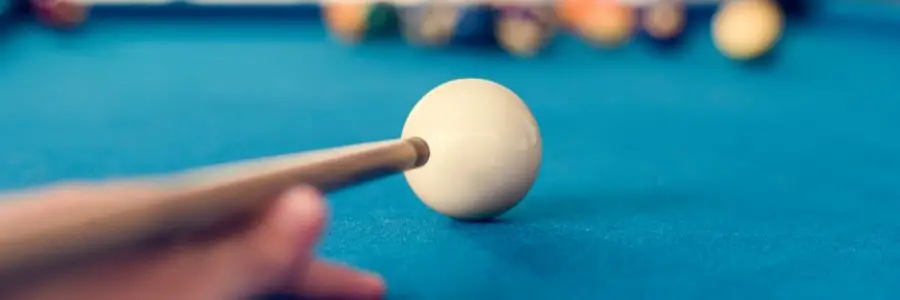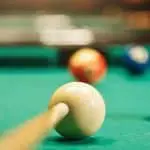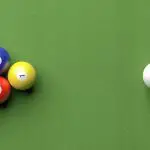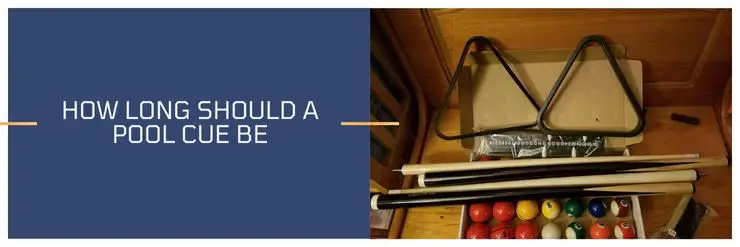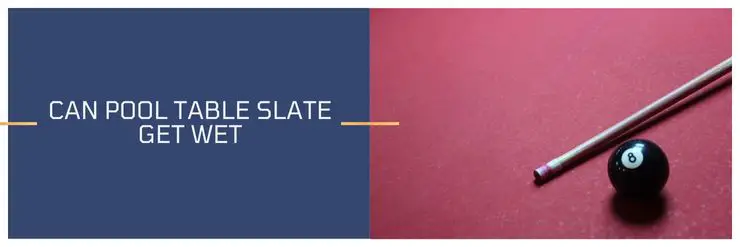Billiards is said to have been derived from the croquet and the first cues were called ‘maces’ which sort of resemble mini hockey sticks.
You’d place the tip over your right shoulder and sweep it in a motion that was more akin to golf than pool.
Eventually, players turned the maces around and found that playing with the thin end was a lot easier.
From there, the pool cue developed into what we see today which is a perfectly manufactured piece of art. Here we look at how they are made and whether premium cues are worth it.
How are pool cues made
In order to answer the question, are expensive pool cues worth the money, we first need to consider how they are made so we can, so we can take into account if they are worth their hefty price tags.
Pool cues are often made in two sections with the shaft and the butt. Players can then unscrew these for traveling or use different shafts for different types of play.
The butt itself is usually made from two pieces of high-quality wood with the wrap and the forearm sides being permanently glued together.
These are lathed into spherical pieces of wood by specialized machines before being bought together.
The Butt end of the cue is where you will have your designs and wraps that will make a cue unique and stand out from the crowd.
Creating The shaft is usually a plain piece of high-quality wood that is all about performance and accurate cueing, usually to achieve this special technology will be added to the inside of the shaft
At the top end of the cue, a ferrule and tip will be added and at the bottom end, a butt sleeve and bumper will be added for protection and balance.
In between, there will be the joint and pin to securely connect the two sides without any play between them.
All these components of the cue are also specially designed and developed to get the maximum from the cue.
What I’m trying to point out is, pool cues are crafted pieces of fine-tuned technology. Every aspect of the cue has been designed in such a way to optimize the performance while looking aesthetically pleasing.
Companies are spending big bucks on research and development, patenting technology to ensure their cues are packed with innovation and enhancements.
So, are expensive pool cues worth the money? Does it justify spending $1000 on a cue?
What materials are the most popular
While other sports such as tennis may have moved on from wooden equipment, the likes of baseball and pool still use wood for premium quality. That being said, there are other materials that have been used for pool cues which are worth considering.
Wood – This is what the premium quality cues are going to be made from. The butt of a cue can be made from a variety of different hardwoods but the shaft is often made from hard maple. Cheaper wooden cues will be made from cheaper sources of wood.
Fiberglass – Fiberglass cues are seen as a good alternative as they still have good performance but can be a lot cheaper. They are bonded into a spherical shape, often around a wood core. They are good, cheaper cues but until recently lacked performance. Advances in the way they are made means you are seeing boned cues made for more advanced players.
If you would like to know more on Fiberglass vs Wood Cues, I wrote an article about it.
Hybrid – There is also a move towards hybrid cues where you have a much bigger wooden core and a wrapping of fiberglass which can be great for added design. They are still not seen as good substitutes for wood.
Metal – Aluminum or titanium cues are cheap but lack performance. they are straight and strong cues.
What makes a good pool cue
What’s vitally important in a pool cue is the transfer of energy, it needs to be smooth and consistent throughout the stroke.
Premium tips are vital as they help improve accuracy while protecting the wood behind it. It dampens the force of the stroke and reduces vibrations. Premium layered tips also come at a cost.
The shaft needs to be made from high-quality wood that is highly durable and gives you that perfect ‘feel’ when you strike the cue. Low deflection shafts are also brilliant pieces of technology as these will allow you to hit the side of the ball and ensure the ball moves straight rather than veering off to the side too much. This improves accuracy and makes putting spin on the ball easier.
Having a high-quality ferrule is important as this will protect the shaft from splintering and is essentially there to take the punishment and ensure the shaft lasts longer.
The joint and pin on a high-quality cue will act as a damper and give you a very tight fit.
Having a wrap on the pool cue is going to be preferable if you’re playing at a high level. These will prevent you from having to worry about sweaty palms and losing grip. They will also prevent the wood from moisture damage.
Other things to consider while talking about what makes a good pool cue are the balance and weight of the cue. This is more suited to the individual but you need to ensure your cue is balanced to your liking. For a lot of cues, using a pool cue bolt system, you are able to adjust the weight of the cue at the butt of the cue.
Are looks important to a good cue? If you think they are then you’ll care about the design on the forearm of the cue. These can really be works of art and be exceptionally beautiful. The wrap can also be styled depending on material or color.
What pool cue do you get for your money
I will try and break down the features you will be getting at different price points.
Hopefully, this will help distinguish and help us make a better judgment on whether expensive pool cues are worth the money or not.
But it’s worth noting that it’s a combination of efforts that determine the quality of the cue, not just one thing.
One big factor between a cheaper cue and a more expensive cue is the shaft.
The construction and technology, such as low deflection technology, are usually a big indicator of the cues overall quality.
That being said, good cues don’t need to be low deflection, but it does help with the accuracy of your shots.
Starter/beginner cue – 30 – $150
Cues at this price range will come with a standard shaft. Nothing special about it. It’ll be a nice straight shaft.
The materials used will be suitable, but not the best.
Chances are they are mass-produced to keep their costs down, such as the Lucky range of cues from Mcdermott or Impact range of cues from Action.
They will most likely make use of stickers instead of nicely crafted inlays and the shaft of the cue being made from cheaper woods or graphite.
The wood will not have the same level of treatment and more likely to warp over time.
The tip is usually of less quality making use of cheaper leather.
Check out Best Pool Cues Under 200 to know more.
- An example of cues at this range would be Viper Desperado(Amazon Link)

This is a good example of a cue which is still high-quality but doesn’t have all those top-end features. It’s still made from maple wood but the detailing isn’t quite as intricate and the tip not quite premium quality. It has an ok leather wrap it’s not low-deflection and the tip and ferrule are ok, but not premium, quality. It’s a great beginner cue but doesn’t have those expert features.
It still adds up to a brilliant cue.
If you would like to know more about this cue, check out the Viper desperado Pool Cue Review
While other sports such as tennis may have moved on from wooden equipment, the likes of baseball and pool still use wood for premium quality. That being said, there are other materials that have been used for pool cues which are worth considering.
Wood – This is what the premium quality cues are going to be made from. The butt of a cue can be made from a variety of different hardwoods but the shaft is often made from hard maple. Cheaper wooden cues will be made from cheaper sources of wood.
Fiberglass – Fiberglass cues are seen as a good alternative as they still have good performance but can be a lot cheaper. They are bonded into a spherical shape, often around a wood core. They are good, cheaper cues but until recently lacked performance. Advances in the way they are made means you are seeing boned cues made for more advanced players.
Hybrid – There is also a move towards hybrid cues where you have a much bigger wooden core and a wrapping of fiberglass which can be great for added design. They are still not seen as good substitutes for wood.
Metal – Aluminum or titanium cues are cheap but lack performance. they are straight and strong cues.
If you would like to know more on Fiberglass vs Wood Cues, I wrote an article about it.
Intermediate cue $150 – $300
Cues at this range start to become a little more advanced. Players who have started to develop their game and are taking it more seriously will opt for a cue at this range.
Here you’ll see a difference in the overall quality of the cue and its playability, especially if you invest in the higher end of this price range.
The price point means cues at this range, such as Viking pool cues or Players HTX range of cues are still produced at volume but with greater detail.
The wood will be of a higher grade with some cues making use of Tiger maple wood or rosewood. Maybe some will use overlays but higher-end may construct the butt using detailed inlays, which will add a significant amount to the overall price. The tips and ferrule will be of better quality, maybe layered tips making use of Japanese pigskin and high impact ferrules.
The playability of these cues will be noticeably better. The higher priced cues may have low deflection technology built into the shafts to improve accuracy.
- An example of a cue at this level would be the PureX Players Technology Series HXT15 (Amazon Link)

As you can see with this cue, it’s made from hard maple and has a high-quality pig skin tip. The shaft also has low-detection technology to create more accurate shots. On the butt, it has beautiful inlay with a Irish linen wrap. It has all the qualities that we have looked at here in perfect display.
For more information about this cue, check out the PureX Players Hxt15 Pool Cue Review article I wrote.
Serious players cue/entry level custom cue. $300 – $500
When you start to explore options at this range you will be struck at how well-made they are. One of the main factors that place these cues here are the details in the design, likewise, with a custom made cue, the time and effort required to craft a cue doesn’t come cheap.
Usually you will find a shaft that is constructed better, the aesthetics are more pleasing and intricate. The other aspects of construction will most likely be on par with a $250 cue – the joint and pin will most likely be of the same standard, weight bolts and tolerances will also be the same.
Most serious players will end-up with cues around this price range. They will play very well and look great.
If you’re interested in knowing more about Best Pool Cues Under 500, I wrote an article about it.
- An example of a cue at this level would be the Cuetec 15K (Amazon Link)

This Cynergy 15K Carbon Composite Shaft goes above and beyond other Cuetec cues, not many Cuetecs are at this price point but this one deserves its place. This rivels the Revo at a much cheaper price. Noticeably this cue makes use of carbon fiber for an extremely straight and smooth shaft which is reinforced by a poly-foam core. This shaft is cutting edge stuff.
High-end cues/mid-range custom cues $500 – $1000
Some popular brands at this range would include Predator, Mezz, and Jacoby. They will be constructed using the best materials and utilizing the best technology available. Most of the shafts will be LD.
Perhaps cues at this range will make use of more exotic hardwoods like Cocobola, East Indies, Bubinga and Pau Ferra which are all part of the rosewood family.
Cocobola gives some end compression, which transfers into a little cue ball action. It’s the 2nd most dense wood in the world which creates a nice action hit.
Bubinga and Pau Ferra play nice with a mid-range hard hit and are slightly heavier than East Indies rosewood.
The latter plays more like maple but produces a slightly harder hit.
It’s safe to say that cues at this range are of excellent build quality, their playability is of the highest order and they look exceptional.
Especially custom-made cues with highly decorated inlays and rings being made from expensive ivory, abalone, turquoise or colored pearls to name a few.
All the technology and special features available to improve the playability of the cue are at this level, anything after this is usually for high-end custom cues or collectibles.
- An example of a cue at this range would be Lucasi Hybrid(Amazon Link)

This beauty of a pool cue is exceptional from leather wrap to layered tip. Every little detail is eye-catching. The material, inlays even joints have had special attention to creating an all-rounded pool cue so it goes as no surprise that it’s low deflection, too.
high-end custom cues or collectibles. $1000 +
When you are hitting this price range you will mainly be looking at playing cues like the ones talked about in the previous section or higher-end custom cues or collectibles.
If it’s a playing cue, then you are obviously paying for its playability but also the brand.
Custom cues, you will be paying for the maker, such as sugartree, as well as the expensive materials used and the time it takes to make.
Makers at this level will have proven their skills and craftsmanship to the point where there might even be a waiting list before you can have your cue made.
Only the most premium materials will be used with every attention taken to detail.
Collectables $5000 +
These cues are purely for collecting and not to be played with. They are very pleasing on the eye.
Playability will most likely be very poor because they are not meant to be played with, just enjoyed. Consider these not like cues but pieces of art.
Will i play better with an expensive cue
Take money out of the picture and what a good cue boils down to is how it feels when you play with it.
The feel of a cue is a personal one and one that makes you feel comfortable.
All the tech in a cue is there to help, and it does. But it’s not essential.
A pro would still most likely beat you using a house cue.
Is $500 high-end cue better than a $100 pool cue? Of course, it is.
The wood is denser, it will make use of better tips, the shaft will be more advanced, the cue overall will be better balanced, the thread and wrap will also add to the playability of the cue; this is to just name a few factors.
All this being said, you can still play well with a $100 cue. You certainly won’t play 500% better with a higher-end cue, so pick one that’s suitable for your level, budget and most of all, one that feels right to you.
When you start to improve you can then consider getting a better cue. I can’t stress this enough, the price of the cue isn’t the only factor to consider, its how it makes you feel and how you play with it. In my opinion, this is one of the most important factors when picking a pool cue.
Are expensive cues worth it
In short, yes. But only to a certain extent.
You’ll find a big jump in quality and playability between a starter cue and an advanced cue but after that, the difference is more about slight tweaks and styling and custom cues.
Everything except the inlay improves the performance on a high-end cue.
If you want to look for a cue that is great to play with at a great price then it’s a good idea to look for one that has all the high-end features we’ve seen but not quite the same level of detail.
Serious players, however, love their cue and having a beautiful inlay is an important part of that. You generally get what you pay for with a cue but firstly you want to make sure that it plays well and feels great.
Anything after that is a bonus.
Rob is an avid player and fan of all cue sports, particularly 8-ball, and snooker. He has competed in a few local 8-ball tournaments and although he is not a professional, he can compete with the best of them.

